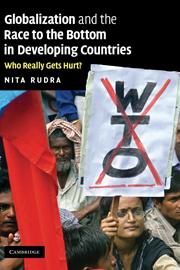Book contents
- Frontmatter
- Contents
- List of figures
- List of tables
- Preface
- 1 Introduction
- 2 The race to the bottom in developing countries
- 3 Who really gets hurt?
- 4 LDC welfare states: convergence? What are the implications?
- 5 Globalization and the protective welfare state: case study of India
- 6 Globalization and the productive welfare state: case study of South Korea
- 7 Globalization and the dual welfare state: case study of Brazil
- 8 Conclusions
- Appendix A LDC social spending
- Appendix B Assessing potential labor power
- Appendix C Additional tests for the RTB hypothesis
- Appendix D Variables in the inequality model
- Appendix E Technical notes on Gini coefficients
- Appendix F LDC Gini coefficient statistics
- Appendix G Robustness check
- Appendix H Conditional impact of trade on inequality
- Appendix I Descriptions and sources of variables
- Appendix J Cluster results minus outcome variables
- Appendix K Dendrogram for cluster analysis
- Appendix L Poverty tables
- Appendix M Social expenditures on social security, health, and education in India (percent of GDP) based on national data
- References
- Index
3 - Who really gets hurt?
Published online by Cambridge University Press: 22 September 2009
- Frontmatter
- Contents
- List of figures
- List of tables
- Preface
- 1 Introduction
- 2 The race to the bottom in developing countries
- 3 Who really gets hurt?
- 4 LDC welfare states: convergence? What are the implications?
- 5 Globalization and the protective welfare state: case study of India
- 6 Globalization and the productive welfare state: case study of South Korea
- 7 Globalization and the dual welfare state: case study of Brazil
- 8 Conclusions
- Appendix A LDC social spending
- Appendix B Assessing potential labor power
- Appendix C Additional tests for the RTB hypothesis
- Appendix D Variables in the inequality model
- Appendix E Technical notes on Gini coefficients
- Appendix F LDC Gini coefficient statistics
- Appendix G Robustness check
- Appendix H Conditional impact of trade on inequality
- Appendix I Descriptions and sources of variables
- Appendix J Cluster results minus outcome variables
- Appendix K Dendrogram for cluster analysis
- Appendix L Poverty tables
- Appendix M Social expenditures on social security, health, and education in India (percent of GDP) based on national data
- References
- Index
Summary
Chapter 2 has established that the fragmented character of labor market institutions in developing countries makes it more likely that the governments of these nations will respond to race to the bottom pressures. Based on this evidence alone, globalization pessimists might claim that their fears are validated, and it is the end of domestic politics in the developing world; the zero-sum dichotomy between states and markets has been confirmed. But the analysis cannot stop here. What is really driving anxieties about globalization amongst academics, activists, and policy-makers is the concern that the race to the bottom hurts the poor. The fight in this case is not for (or against) domestic politics per se, but for the benefit of the less privileged.
This chapter goes a step beyond analyzing the capacity of labor to overcome collective action problems and negotiate policy compromises under globalizing conditions, and observes the effects of domestic institutional arrangements supporting government–labor relations. This approach reveals that the effects of international free-market competition are much more complex than is commonly assumed. While globalization is certainly increasing RTB pressure on less developed countries, the long-time policy interactions between government and select labor groups have engendered a set of social policies that were never designed to help the poor in the first place. Rather, the more privileged classes traditionally receive these benefits, and are therefore the immediate victims of any cutbacks.
- Type
- Chapter
- Information
- Globalization and the Race to the Bottom in Developing CountriesWho Really Gets Hurt?, pp. 48 - 74Publisher: Cambridge University PressPrint publication year: 2008
- 1
- Cited by

